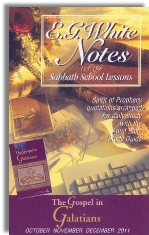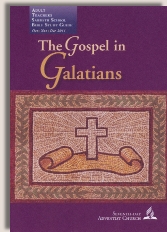|
||||||||||||||
Commentary on "The Priority of the Promise"
Day 3: Monday, October 31, 2011 - Faith and Law
Overview
After entering into Paul’s flow of thought that covers the 3rd chapter of Galatians, the author of the quarterly takes a break and goes to another place for insights regarding the understanding of the law-promise dynamic. He goes to Romans 3:31 as a central argument in order to make the case that the law is not “done away at the cross, as some people today claim he [Paul] taught.”
Observations
Perhaps the writer wants to use the “analogy of Scripture” as a principle of interpretation, in which ideas coming from other biblical books are brought in for the purpose of creating a perspective and a larger context for the text under study. Still, the priority, either logical or temporal, should be given to the closer context, the chapter and even the book of the text. In this situation, the right method is to let Galatians define the meaning of the relationship between law and promise, especially because Paul dedicates a lot of chapter 3 to this subject. While he deals with it in his epistle to the Romans, he’s not writing Romans to correct erroneous views about the relationship between promise and law as he did in Galatians 3. The unique contribution of Galatians comes from the fact that Paul’s words are a needed corrective for those who are inclined toward misusing the law in order to destroy the gospel. It’s a distraction to bring Romans 3:31 into the analysis of Galatians 3 before forming a view from the closer context. The direction of the movement should be from the closer to the larger context, not the other way around, otherwise ideas which may be stranger to the text can be brought into it. Even if they are correct, reading true concepts into the wrong texts is still eisegesis, not exegesis, thus misdirecting the reader toward paths of thought that are not in the text.
A lot of weight is put on the Greek word katargeo, the Greek word translated “overthrow” from the question present in Romans 3:31: “Do we then overthrow the law by this faith?” The negative answer to the question is understood as the opposite of “done away at the cross”. Other places where the word is used are also mentioned, but the author fails to cite Romans 7:6:
“But now we are released from the law, having died to that which held us captive, so that we serve in the new way of the Spirit and not in the old way of the written code.”
Translated as “release”, katargeo qualifies the relationship between the believer and the law. While indeed the law is not katargeo (overthrown), the believer is katargeo (released from) the law. At least this should be acknowledged: the cross may not annul the law, but the relationship of the believer with the law is annulled.
The SDA Bible Commentary is quoted:
“The plan of justification by faith reveals God’s regard for His law in demanding and providing the atoning sacrifice. If justification by faith abolishes law, then there was no need for the atoning death of Christ to release the sinner from his sins, and thus restore him to peace with God.”
Something doesn’t fit in this picture; this argument is an example of a non sequitur. It is concluded that, if justification by faith abolishes the law, the law has no power to condemn, and thus Christ’s sacrifice is unnecessary. On the contrary, the power of the law to condemn needs to be canceled, the sinner needs to be released from this power, and the cross is the necessary instrument for accomplishing this task. If the cross doesn’t release the sinner from the law, it fails to be an adequate means to the end.
“Moreover, genuine faith implies in itself an unreserved willingness to fulfill the will of God in a life of obedience to His law. . . . Real faith, based on wholehearted love for the Savior, can lead only to obedience.”
While it is true that faith is connected with love and genuine faith is accompanied by love, there is confusion in the relationship between faith and love in the above paragraph. Faith is not based on love; love is based on faith; the order is highly important and makes the difference between salvation by grace and salvation by works. Faith is the empty hand receiving God’s gift, love is the full hand giving gifts to God and neighbors. Love for God is based on faith, on what the sinner receives from God, not the other way around. The love manifested by the believer toward God succeeds and springs from gratitude for what he previously received: God’s gift of salvation. The possession of this gift, the possession of full, final, complete forgiveness for sins is the sure basis and root of all obedience to God. In the Adventist scheme of salvation, the final and irreversible forgiveness for sins received at the bar of the Investigative Judgment is based on the sinner’s love for God and neighbor. When it is placed in this order, the believer’s love for God is not rooted in faith, in the already-received gift of forgiveness and eternal life, but it is motivated by the desire to secure the the gift of forgiveness.
This model of “love yields faith” is Christianity standing on its head. The chance that a person can resist temptation and the devil in this awkward position is as great as the chance that the Cheops Pyramid could remain standing if it were turned upside down. Let the reader decide the degree of success this belief could have.
Copyright 2011 BibleStudiesForAdventists.com. All rights reserved. Revised October 30, 2011. This website is published by Life Assurance Ministries, Glendale, Arizona, USA, the publisher of Proclamation! Magazine. Contact email: BibleStudiesForAdventists@gmail.com.
The Sabbath School Bible Study Guide and the corresponding E.G. White Notes are published by Pacific Press Publishing Association, which is owned and operated by the Seventh-day Adventist church. The current quarter's editions are pictured above.
Official Adventist Resources
Standard Edition Study Guide Week 6
Teacher's Edition Study Guide Week 6
Easy Reading Edition Study Guide Wk 6
Search the Complete Published Ellen G. White Writings
Please Support This Project


